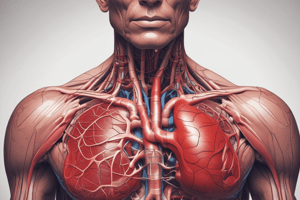Podcast
Questions and Answers
What is the primary function of blood?
What is the primary function of blood?
Transportation, regulation, and protection
Blood is less dense and less viscous than water.
Blood is less dense and less viscous than water.
False (B)
What color is blood that is saturated with oxygen?
What color is blood that is saturated with oxygen?
Bright red
What is the typical pH range of blood?
What is the typical pH range of blood?
What is the lifespan of red blood cells (RBCs)?
What is the lifespan of red blood cells (RBCs)?
Which type of blood cells protect against disease?
Which type of blood cells protect against disease?
The heart contributes to homeostasis by pumping blood through blood vessels to the tissues of the body to deliver __________ and nutrients.
The heart contributes to homeostasis by pumping blood through blood vessels to the tissues of the body to deliver __________ and nutrients.
How many times does the heart beat approximately in a year?
How many times does the heart beat approximately in a year?
What is the average mass of the heart in adult females?
What is the average mass of the heart in adult females?
What is the size comparison of the heart to a common object?
What is the size comparison of the heart to a common object?
What is the pointed part of the heart called?
What is the pointed part of the heart called?
Flashcards are hidden until you start studying
Study Notes
Overview of the Cardiovascular System
- Comprised of blood, heart, and blood vessels; essential for transportation and homeostasis.
- Blood transports oxygen, carbon dioxide, nutrients, and hormones; regulates pH, temperature, and provides disease protection.
Functions of Blood
- Transportation: Delivers oxygen from lungs to cells and removes carbon dioxide for exhalation.
- Regulation: Maintains pH levels through buffers; regulates body temperature via blood flow.
- Protection: Forms clots to prevent blood loss and white blood cells engage in phagocytosis to combat pathogens.
Physical Characteristics of Blood
- Denser and more viscous than water; slightly sticky texture.
- Normal temperature around 38°C (100.4°F), slightly alkaline pH of 7.35 to 7.45 (average = 7.4).
- Color of blood indicates oxygen saturation: bright red when oxygenated, dark red when deoxygenated.
Formed Elements of Blood
- Red Blood Cells (RBCs/Erythrocytes): Carry oxygen to cells and carbon dioxide back to lungs; lifespan of 120 days, produced in bone marrow.
- White Blood Cells (WBCs/Leukocytes): Protect against pathogens; include neutrophils, basophils, eosinophils, monocytes, lymphocytes (B cells, T cells, NK cells).
- Platelets: Cell fragments crucial for blood clotting; release chemicals that promote vascular spasm.
The Heart
- Pumps blood through vessels, essential for delivering oxygen and nutrients while removing wastes.
- Beats approximately 100,000 times a day; equates to about 35 million beats annually and 2.5 billion over a lifetime.
- Pumps around 5 liters of blood each minute, totaling over 14,000 liters (3,600 gallons) daily.
Anatomy of the Heart
- Located in the mediastinum; shape resembles a fist.
- Dimensions: Length about 12 cm (5 in), Width 9 cm (3.5 in), Depth 6 cm (2.5 in).
- Average mass: 250 g (8 oz) in females, 300 g (10 oz) in males; two-thirds mass left of midline.
Ventricular Characteristics
- The left ventricle forms the apex of the heart, critical for systemic circulation.
Studying That Suits You
Use AI to generate personalized quizzes and flashcards to suit your learning preferences.




